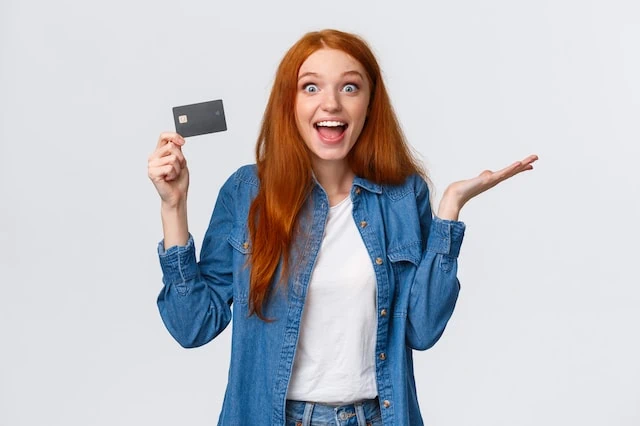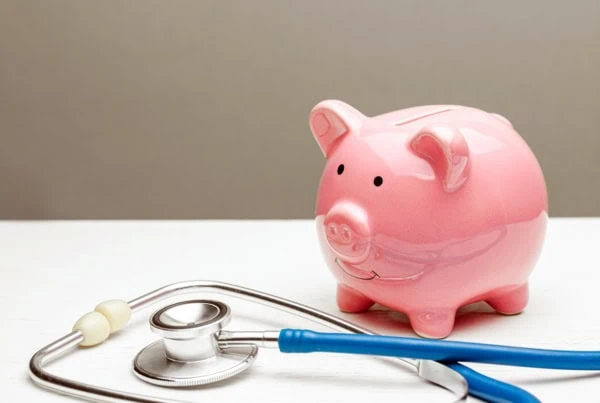There are significant advantages to owning and using credit cards. Using credit cards is convenient, they have better fraud protection than debit cards, make it easy to track spending, and you can receive perks such as cash back and travel rewards.
Owning a credit card is also one of the best ways to establish credit and increase your credit score (assuming you use it responsibly). However, it’s much simpler to get approved for credit cards if you’ve already had one before.
Let’s go over everything you need to know about how to get your first credit card.
Table of Contents
Who Qualifies for a Credit Card?

When you apply for a credit card, credit card issuers consider several factors when deciding to approve your application. They look at your credit history (or lack thereof), age, income, if you have debt, and more.
People with a long history of consistent, timely payments qualify for top cards. Younger people with poor credit scores or who don’t have established credit can often still get credit cards, but the options are more limited.
Related: Best Credit Cards for Teenagers
What is a Starter Credit Card?

Starter credit cards are designed for people who need to establish credit. These cards might be secured or unsecured (more information on this later), like a student credit card and usually don’t have the best terms. They often have low limits and high interest rates.
Typically, you use a starter credit card temporarily until you can prove you’re responsible and financially secure enough to qualify for cards that have better terms. Starter cards are an easy way for someone with no credit to start building some.
Related: Secured Credit Card vs. Unsecured: What’s the Difference?
What Does Having “No Credit” Mean?

Everyone has to start somewhere. That means you initially have no credit but eventually take specific actions like opening a credit account, loan or credit card, which the major credit bureaus deem essential for building creditworthiness—and, by extension, establishing credit for yourself.
Not everyone takes the same path to build credit. Some of your first steps could include:
- Piggybacking on credit cards from others with an authorized user status
- Applying for joint credit cards
- Asking a family member to co-sign on a credit card
- Opening a secured card
- Looking for unsecured credit cards for no credit history applicants
- Going for a credit builder loan or line of credit
- Reviewing credit cards for kids and credit cards for teens
- Accepting “prequalified” offers on unsecured credit cards
The options you have to begin building credit from nothing and establishing a credit score record aren’t one-dimensional. Any of the above actions will work to beef up your thin credit profile.
Taken together, one or any combination of these options will build credit and soon expand on your limited credit history. You will need to work hard to develop good money habits once you get a credit card.
This will include making on-time payments, managing your spending, sticking to a budget well enough to pay off your credit card balance in full each month and more.
Done well and over long periods, the three credit bureaus will award you with a respectable credit score. This allows a credit card issuer with more stringent credit requirements to accept your application—or even grant an existing credit account with a higher credit line.
In sum, when you take deliberate actions to build and improve your credit history, you will qualify for more favorable financing terms, providing you with more financial flexibility.
Try not to look at others with perfect credit scores and think how unfair it is that you don’t have access to the same credit opportunities they do.
You are, after all, in control of your financial destiny with how well you manage money and make responsible decisions when spending.
Remember, everyone has to start somewhere. If you need some form of plastic and don’t feel ready for bona fide credit cards, you can choose to start first with prepaid and debit cards.
This might give you time to manage an account balance and work your way up toward the confidence and responsibility needed for having credit cards in your name.
Related:
- Best Debit Card Options for Kids
- Best Debit Cards for Teens to Learn About Money
- Best Prepaid Debit Cards for Teens & Families [Reloadable]
- Best Free Debit Cards for Kids & Teens [Save, Spend & Earn]
What Do You Need to Apply for a Credit Card?

There are different rules for young adults under 21 years old because of laws on how financial companies market cards towards this demographic.
As a result, you’ll need a few pieces of information, financial resources or help from another. Specifically, you’ll need the following in most cases:
- Identifying information. This includes a Social Security number or an individual taxpayer identification number (though some cards don’t require you to have this as you might be an international student applying for a card).
- Income sources or financial resources. This money can be earned or owned by yourself, but it can also be money you have a reasonable expectation of access for repaying the debts incurred on the card. This means you can have money from a third-party source count as income, such as if you have a spouse who works or has funds and you don’t work yourself.
- Monthly cost-of-living information. This includes costs like rent or housing payments.
If you don’t have income sources of your own and are between 18 and 21, you may need to ask someone to co-sign your application, add you as an authorized user on their card, or apply as a joint applicant.
How to Get a Credit Card with No Credit

Getting your first credit card requires making trade-offs. In exchange for having no credit history, your credit card issuer may want to have more protection for themselves, uncertain of how you’ll handle credit.
This might mean higher interest rates and lower credit limits. So, while they might approve you for a card, you might need to pay more on interest to start if you can’t pay off your balance in full each month.
Making your monthly payments on time each billing cycle can put you ineligibility for other cards that carry higher limits and lower interest rates—as well as other attractive features.
That means not always only having credit cards for no credit history applicants in your wallet.
To get a credit card with little credit history, you should begin with starter credit cards like a secured or student credit card.
Student credit cards focus on college students who haven’t built credit yet but want functional benefits like good grades credits, cash back rewards on their combined purchases, and no annual fee.
Secured credit cards require a refundable deposit to open, which then becomes your credit limit. These act like an unsecured card by allowing you to make purchases against a line of credit which you must then pay off each month to avoid paying interest.
Handling these purchases and payments well for several months may qualify you for an unsecured card and receiving your deposit back.
You might also ask a loved one to become an authorized user on their card. If they have a good track record of using credit responsibly, such as making on-time payments and having low balance levels each month (less than 30% utilization), this will also help you build your own credit.
This card will come with your name on the account, though you don’t carry any responsibility for making payments.
Related: Best Credit Cards for Students with No Credit
How to Find the Right First Credit Card

1. Look at where you currently bank
If you enjoy the bank or credit union where you currently have a bank account, that’s a great place to look into first. It may be easier for you to get approved for a card with your current bank because a relationship already exists. However, if competitors have far better deals, don’t worry about being loyal to a bank and instead pick the best card.
2. Look at available offers – secured cards, pre-approved unsecured credit cards
Depending on the offers, it may be best to get a secured card (where you give a security deposit), a pre-approved unsecured card, or something else. See which cards you’re likely to be approved to get. There might be some that require an established credit score.
3. Understand the terms, trade-offs and how each type of credit card works
Read the fine details for each card. Check interest rates, the credit card limit, whether there is an annual fee or other fees, and if they report your card usage to credit rating bureaus.
4. Target cards with low fees, report credit to credit bureaus
Focus on cards with low or no credit card fees. Try to get a card with no annual fees, if possible. If you plan to travel abroad with your card, you’ll also want to look into foreign transaction fees.
Fortunately, there are cards with no foreign transaction fees if that’s a priority for you. You want your card use to be reported to major credit bureaus to establish credit and help towards a high credit score.
5. Apply to rewards credit cards if possible
If you might qualify for a rewards credit card, apply for it. The sign-on bonuses can sometimes be substantial, and you could earn cash back or other rewards.
Typically, you can apply cashback earnings right to your balance, and the lower your balance, the easier it is to pay off each month. Your rewards card might have an annual fee, but if you earn back more than you spend, it’s still a good deal.
How to Apply for a Credit Card for the First Time
1. Fill out application
You can usually fill out your application online. Alternatively, you can call the credit card company or visit a bank. The form will ask for personal information, such as your full name, address, Social Security Number, and more.
2. Report All Eligible Forms of Income and Savings
Even just having a part-time job is typically sufficient income for credit card companies to consider your income high enough.
Besides employment, you should include other forms of eligible income, such as student loans, investments, government benefits, a spouse’s income, alimony, or child support. Share any savings accounts you have as well.
3. Provide Living Expense Estimates (e.g., Rent, Mortgage)
You will need to provide how much your living expenses cost by sharing how much rent or mortgage you pay. When you split rent with roommates, you only need to list your portion of the rent and not what everyone pays combined.
If you live with your parents and they have you pay rent, be honest about that expense. If you live there for free, that number is zero. You don’t need to include utility expenses because those are variable rather than fixed costs.
4. Receive Approval (Instantly or By Mail)
In some situations, you might receive instant approval. If you aren’t approved instantly, you might still be approved by mail after your application has been thoroughly reviewed.
If you’re denied, contact the card issuers—they possibly declined your application due to an error rather than a valid reason for rejection.
What is a Secured Credit Card?

A secured credit card is a type of credit card that requires you to put down an upfront cash deposit, usually equaling the amount of your credit limit.
This cash security deposit helps protect the credit card company from recognizing a loss by issuing you a credit card and failing to receive payments.
Secured cards typically work best for individuals with no credit or looking to rebuild bad credit.
The cash deposit establishes collateral the credit card issuer may claim in the event of default or failure to make timely payments.
How Does a Secured Credit Card Work?

Often, a secured card works as the first step for young adults or people who don’t have an established credit history to have access to credit. They also work for consumers with poor credit.
Secured credit cards work by having the cardholder front a required deposit to open an account, reducing the risk to the credit card issuer of you defaulting or missing a payment.
Usually, minimum deposits are in lower denominations, between $200 to $500 to start. This represents your credit limit and also financial protection for the financial institution issuing the card.
Once you apply for a secured credit card and make the security deposit, these work like any other card.
Where they differ from a traditional credit card comes through requiring a cash deposit upfront (usually a refundable security deposit) and often running no credit check as a result.
Unsecured credit cards don’t require an initial deposit and usually run a credit check to determine eligibility and whether you are likely to use the card responsibly.
A card company may let applicants get automatically considered if their credit profile carries excellent credit or if they apply for a secured card.
Related: 11 Best Stock Trading Apps & Platforms for Beginners
How to Establish a Credit Score with No Credit History

Starting with no credit can be a challenge if you don’t know where to begin. Consider the following steps to establish a credit score when you don’t have a credit history.
Authorized User
Authorized user status is often the first step many take on the credit building journey. Having someone willing to add you as an authorized user will enable you to build credit by using their available credit.
This card should be in good standing, not maxed out, and the primary account holder should have a history of on-time payments with this card.
Apply for an Unsecured Beginner Credit Card
You can also start by applying for a beginner unsecured card. These cards will allow you to establish a credit history without the need for collateral. Before applying, check your “pre-qualification” rate online and determine if an application fee is associated with this card.
Apply for a Secured Card
Likewise, you can also apply for traditional secured credit cards if no unsecured card offers appear available. A secured option requires you to make a deposit upfront which then becomes your credit limit.
From there, secured cards work just like an unsecured credit card. Credit card issuers want to see how you handle the secured card in your possession.
If you can pay your bills and stick within your credit limit over enough time (usually 3-6 months, but sometimes longer), the credit card issuer will offer to convert your secured card into an unsecured card.
Review Prequalified Credit Card Offers that Report to Credit Bureaus
Likewise, you can also review any prequalified offers that come to you directly. Be judicious to make sure the card makes sense for your needs, reports to all three credit rating bureaus, and doesn’t charge an annual fee (or at least a small annual fee).
Maintain Good Spending Control
Undoubtedly, the chief concern for building credit comes from having control over your spending habits. Building credit requires discipline, so make sure to stay within your budget and only purchase needed items.
Make Payments On Time
Closely related to maintaining good spending habits is making sure you pay your monthly card statement on time.
This factor is one of the most significant components of determining your credit score as it proves creditworthiness the most: you honor your obligation to repay debts you borrow.
Pay Off Your Credit Card Bill in Full
With a credit card, it’s essential to make sure that you pay your balance in full every month. Failure to do so will result in interest charges and negatively impact your credit score if the balance represents too large a percentage of your overall available credit.
Maintaining a low credit utilization rate can prove to lenders that you don’t need credit; merely use it as a convenience or a tool—not a necessity. As odd as it seems, you get the best credit scores by having a lot of available credit but never using it.
Keep the Account Open and Do This On Repeat
When establishing a credit history for yourself, the most challenging part might be knowing it won’t happen overnight.
A history of repaying your debts on time, managing your finances, limiting how often you access credit and diversifying the credit sources you rely on replicated over many years affects your credit score by as much as 15%.
When you open new credit accounts, try to keep them open if at all possible. Closing your account can affect your credit score negatively by lowering the average age of your accounts.
Further, closing an account can reduce your available credit and thus possibly increase your credit utilization ratio.
If you want to open card accounts you intend to hold for long periods, whether you use them or not, consider no annual fee cards, so you don’t need to pay to keep the accounts open.
If you have a card with an annual fee, you might consider contacting the issuer to see if you can change from your current card to another one without an annual fee.
This maintains the account age but lowers your annual expenses for maintaining your credit.
Related: A Closer Look at all the Types of Credit Cards & How They Work
What is a Credit Score?
A credit score is a number that predicts how likely you are to repay borrowed money.
It’s a three-digit numerical representation of the information in your credit report, managed by the three major credit bureaus: Equifax, Experian, and TransUnion.
This score ranges from 300 to 850 under the FICO scoring system, with lenders looking at these numbers when deciding whether or not to approve potential loans.
The most critical factor in determining your score is payment history, accounting for about 35% of the total. The other most significant factors are amounts owed (30%) and length of credit history (15%).
Balances on different types of loans make up less than 15%, while new account activity only contributes about ten percent.
Building good credit doesn’t happen overnight, as it measures your ability to manage loans and lines of credit wisely and responsibly over time.
Related: How Old Do You Have to Be to Have or Open a Bank Account?
Should I Get a Credit Card at 18?

Yes, in almost all situations, it’s wise to get a credit card at age 18. This is the youngest you can get a card on your own. Credit cards help you build credit, and you want to start building credit as early as possible.
One of the most critical factors in one’s credit score is the length of credit history.
If your credit report shows a long history of paying on time and that you have low debt, you’re likely to have a high score, which will help you financially in the future.
Remember that credit cards don’t create free money, and you want to pay your credit card bill in full every month so you don’t accumulate debt.
Related: Battling a Thin Credit File: What It Is & How to Fatten it Up
How to Increase Your Credit Limit

Most likely, your first credit line will have a low limit.
Sometimes, credit card issuers will automatically increase your credit limit after you’ve been responsible with your card for a certain amount of time. Other times, you’ll have to contact them and request an increase.
You might be able to make your request online. Calling your card company and discussing your credit limit is also an option.
Be prepared to update your income, employment status, and expenses. A higher-income improves your chances of a higher credit line being approved.
You’re unlikely to get approved if you frequently miss payments. If you are often late on payments, fix that habit first.
Alternatively, you could apply for a new credit card that comes with a higher limit. This method also makes it so you have more overall available credit.
Note that sometimes requesting a credit limit increase means you’ll get a hard inquiry, which can negatively affect your credit score.
It will only affect it temporarily (and usually minimally) but should increase your score in the long term.
If you need a high score for something soon, such as getting a car lease, keep this in mind.
If so, you may want to wait until after your lease or other loan is approved before getting a hard inquiry. Some credit card companies only do a soft pull. Check your company’s system.
Related:
- How to Build a Good Credit Score and Why It Matters
- 5 Easy Ways to Build Credit as a College Student: What to Know
How to Use Your First Credit Card

To be successful with your first credit card, act more like a tortoise than a hare. Don’t quickly max out your card and then get distracted and miss payment deadlines. Instead, be slow and consistent like a tortoise.
Start by making small purchases and keeping your account balance low. You want to have a low credit utilization ratio, preferably under 30%.
The number one factor in your credit score is whether you consistently pay your bills on time.
Make sure you consistently pay at least the minimum (the complete statement balance if you want to avoid interest) by the due date.
Don’t be too scared that you never use your card. Regular usage is essential, too—don’t go overboard. If your checking account has sufficient funds, setting automatic payments can ensure you never miss one.
Additionally, make sure you are well versed on any fees associated with your card, such as annual fees, foreign transaction fees, late fees, balance transfer fees, cash advance fees, and more.
Review your statements to ensure everything is in order and there are no fraudulent charges or unexpected fees.
Unless you use a secured credit card, plan to keep your first credit card as long as possible because canceling it can negatively impact your credit score.
Related:





![How to Get Free Money Now [13 Ways to Earn Money Today] 30 how to get free money](https://youngandtheinvested.com/wp-content/uploads/how-to-get-free-money-600x403.webp)

![8 Best Debit Cards for Teens [Reviewed by a CPA + Father] 32 best debit cards for teens hires](https://youngandtheinvested.com/wp-content/uploads/best-debit-cards-for-teens-hires-600x403.webp)
